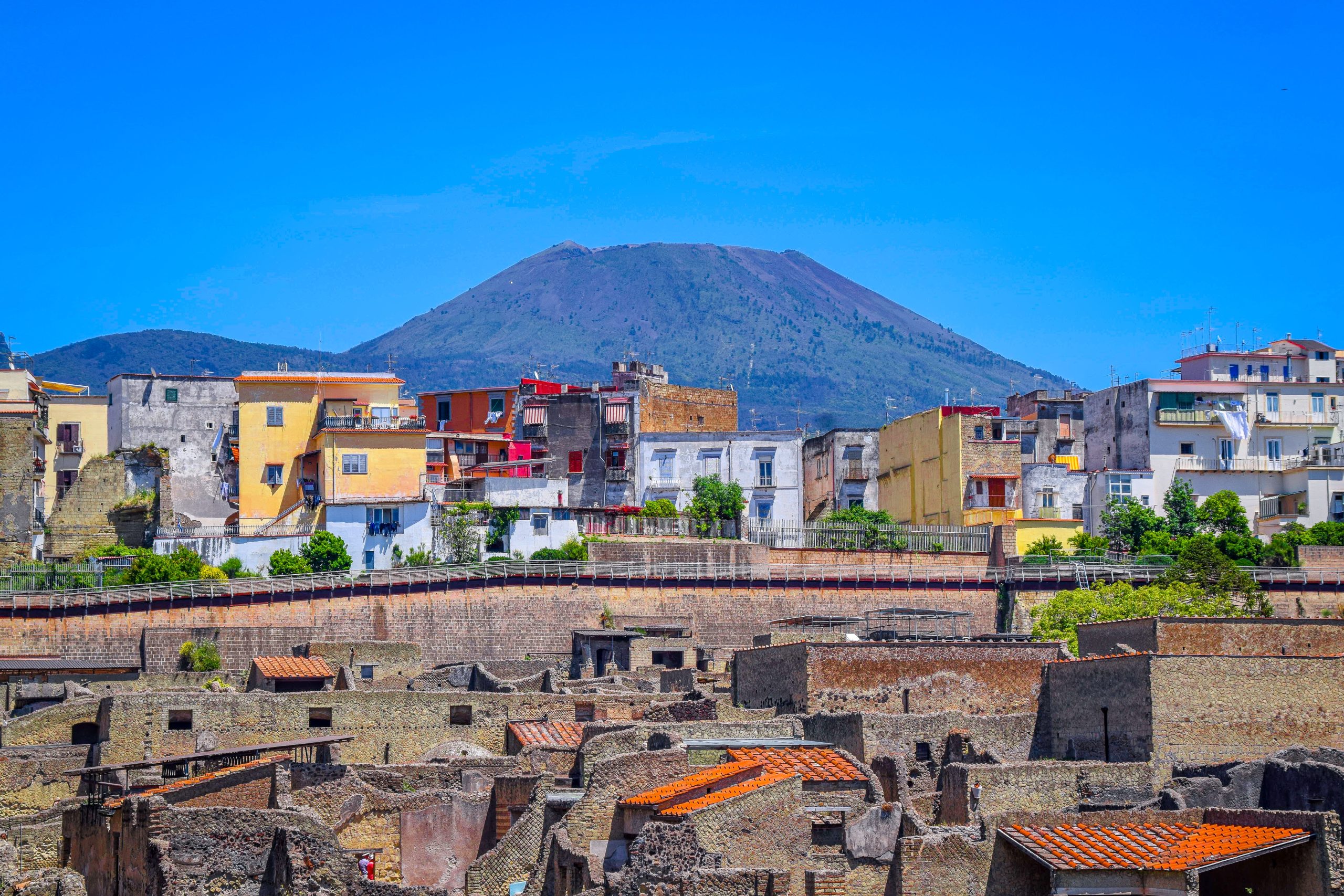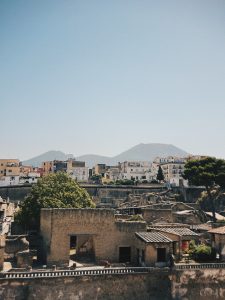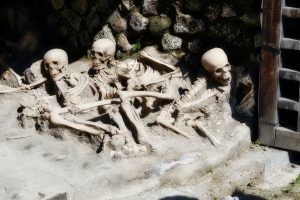Exploring Pompeii’s Neighbor: Herculaneum, the Lesser-Known Buried City

The ancient Roman city of Pompeii is justifiably famous throughout the world. Completely buried in ash by a volcanic eruption of Mount Vesuvius in A.D. 79, Pompeii is one of the best-preserved Roman cities in the world. Wandering the ancient streets is about as close as you’ll ever get to hopping in a time machine and traveling back to the early days of the Roman Empire, and that makes it one of the most popular tourist attractions in southern Italy.
Prior to the Covid 19 pandemic, Pompeii was receiving close to four million visitors every year. That’s quite astonishing, given that the upper estimates for the population of the city at the time of the eruption were only 20,000. But it also means that you’re not going to be able to escape the crowds in this town, especially during the busy summer season.
However, few people are aware that if you want to explore an incredibly well-preserved Roman town, Pompeii is not the only option. Herculaneum was buried by the same eruption that killed Pompeii, but the city has not been excavated to the same extent as its more famous neighbor and is therefore much less well-known. And yet, Herculaneum is probably even better preserved than Pompeii. Plus, with smaller crowds, it will be easier to imagine yourself back in the time of the Romans when this was a bustling port city.
If you’re a real archaeology buff, or you just want a less crowded experience of Italian history, Herculaneum makes a great alternative to busy Pompeii. You can drop off your bags at a convenient suitcase storage near Pompeii and make a short train ride to reach ruins that are just as spectacular but far less crowded.
The story of Herculaneum

Herculaneum lies about a kilometer from the coast now, but that’s because this geologically active region has risen slightly since Roman times. Back then, Herculaneum was a major port and trading post. Whereas Pompeii was mostly a resort for wealthy Roman aristocrats to have seaside villas, Herculaneum was a working town built on fishing and Mediterranean trade.
Although both cities were buried by the same eruption, Herculaneum initially seemed like it might be spared. The prevailing winds carried the first volcanic material to Pompeii, with only a little ash falling on Herculaneum. That gave the residents time to flee the eruption, creating one of the major differences between Herculaneum and Pompeii. You won’t find the plaster casts of bodies buried in ash at Herculaneum like you will in Pompeii because most of the residents escaped.
However, the light dusting of ash that Herculaneum received meant that the roofs of buildings did not cave in the way they did in Pompeii. And when a later stage of the eruption enveloped the city in the same pyroclastic flows that killed Pompeii, it also immediately carbonized wood items like building timbers and furniture, preserving them underneath several meters of ash.
Herculaneum was rediscovered in 1709, a few decades before the first excavations began at Pompeii. However, the later discovery of Pompeii meant that resources were diverted to exploring that city since digging there was much easier. Pompeii was buried under around four meters of ash and rock, while Herculaneum lay beneath around 20 meters.
That’s a blessing in disguise. Not only did it help to preserve the ancient city, but it also spared it from the fairly destructive archaeological techniques of the 18th and 19th centuries. Today, Herculaneum remains an active archaeological dig, but enough of the city has been unearthed to make it a fascinating place to explore and an ideal alternative to Pompeii.
What to see in Herculaneum
The smaller size of Herculaneum compared to Pompeii makes it easier to visit in many ways. A couple of hours is enough to see most of the city, which isn’t true for its more famous neighbor. Here are some of the best places to see:
- The men’s baths.
- Hall of the Augustales. This stunning building was once owned by a cult dedicated to Emperor Augustus and is one of the most beautifully decorated in the city. The skeleton of the building’s custodian was found in his quarters during excavation, still taking care of the building 2000 years later.
- House of the wooden partition. The remarkable preservation of wood is something that sets Herculaneum apart from Pompeii and is the reason why you can see many two-story buildings here. Check out this house to see a perfectly preserved wooden partition that divided the open spaces of Roman houses from each other to provide privacy and decoration.
- Fornici. Herculaneum doesn’t have the human remains you’ll find at Pompeii since the city was mostly evacuated. But not entirely. The fornici are the old warehouses of the town port where city residents fled to be evacuated by boat. In the 1980s, 300 skeletons were excavated here, along with personal objects like coins that they had tried to take with them as they fled the eruption.
How to get to Herculaneum

The archaeological Park of Herculaneum lies in the modern town of Ercolano. The town has a train station called Portici-Ercolano, and it lies on the Circumvesuviana line that carries tourists from Naples to Pompeii.
This train can get extremely busy, and it isn’t in the best condition, so another advantage of visiting Herculaneum is that it is closer to Naples than Pompeii, meaning you can get off several stops earlier. You can also opt to ensure you get space on the busy train by catching it at Porta Nolana, the stop before Napoli Centrale, which is where most tourists get on. The train ride only takes about 16 minutes.
From the station, it’s an uphill walk of just under two kilometers to reach the entrance to the ruins. The park isn’t hard to find; signs lead the way, and a huge stone wall surrounds the excavations, which you can follow to reach the gate on the eastern side of the city. You can also take bus route 5 from the station to the ruins.
Herculaneum: a better Pompeii?
There is no right answer to the question of which Roman city is best to visit, Pompeii or Herculaneum. Herculaneum is better preserved, less crowded, and much more manageable in size. Still, Pompeii has the haunting plaster casts of the residents and several structures Herculaneum doesn’t, including an amphitheater and several theaters.
But if you’re pressed for time or just really want to avoid crowds, Herculaneum makes a great alternative to Pompeii. You’ll have the same experience of traveling back in time but may find it even more memorable since it’s not as overrun by tourists as its famous neighbor.




